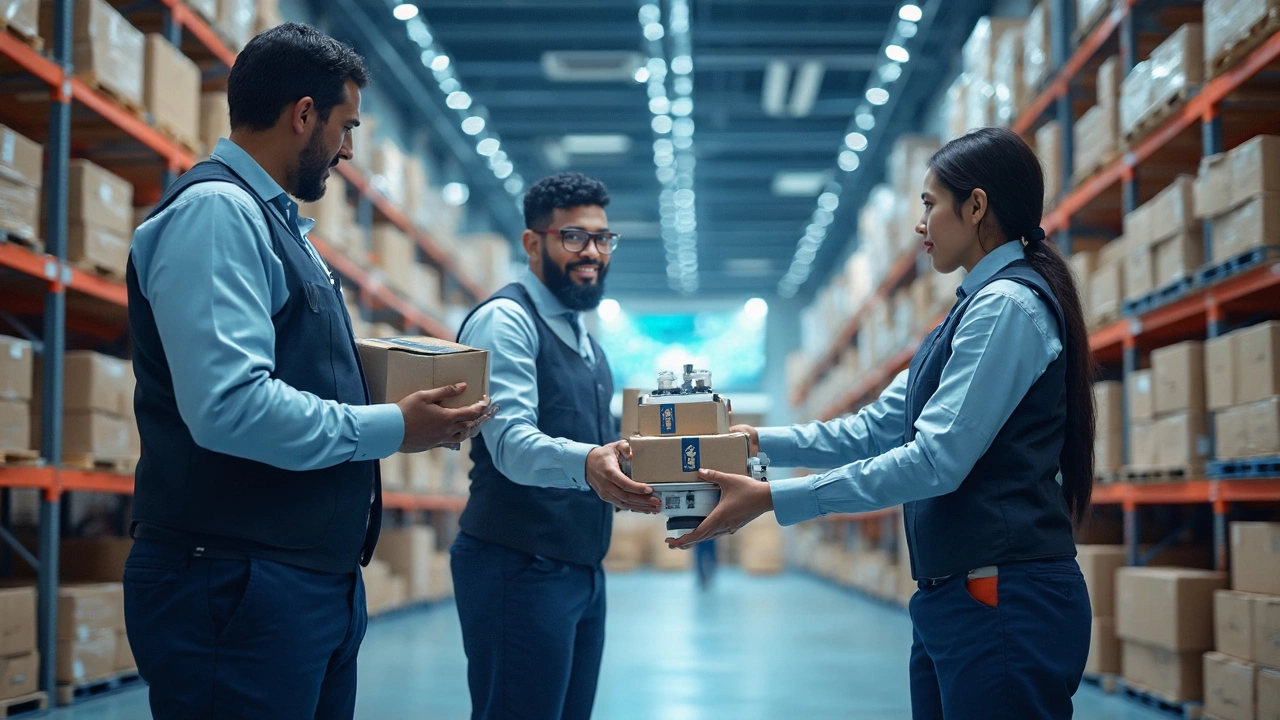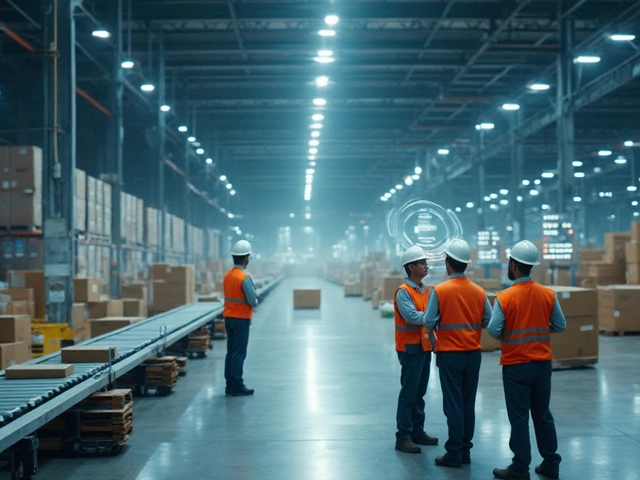So, you've probably wondered at some point if Amazon is literally a courier service, right? It seems like they're everywhere, delivering packages at lightning speed. But hold on—while Amazon sure knows a lot about deliveries, it isn't your traditional courier service in the strictest sense.
Amazon has built an impressive logistics network over the years, mainly to support its huge retail machine. They've got fulfillment centers dotted all over the place and even their own fleet of trucks and planes. But unlike FedEx or UPS, Amazon doesn't aim to be just a delivery company for anyone out there. They've put all this together primarily to get stuff to customers who shop on their platform and increase the convenience factor.
- Amazon's Logistics Network
- Amazon vs Traditional Courier Services
- The Impact of Amazon on Delivery Expectations
- Amazon's Latest Delivery Innovations
- What This Means for Businesses
Amazon's Logistics Network
Amazon's logistics network is like a well-oiled machine to keep millions of packages flowing smoothly across the globe. Unlike traditional courier services, Amazon's network exists specifically to handle its massive online retail operation. Let's break down what makes Amazon's logistics so unique.
Fulfillment Centers Everywhere
Amazon's got these massive warehouses, known as fulfillment centers, strategically placed all over the world. They store tons of products, allowing Amazon to meet that speedy delivery promise we all love. These centers are located close to major urban areas, reducing delivery times significantly. Last checked, Amazon had over 400 fulfillment centers globally.
Amazon's Delivery Fleet
When it comes to logistics, Amazon isn't just relying on other delivery services. They have Amazon Air, a dedicated cargo airline, ensuring quicker air freight. Have you seen those branded delivery vans around your neighborhood? That's Amazon Flex, its fleet of delivery vehicles including everything from bikes to trucks. In some areas, they're even testing drones! Drones! Talk about future-forward.
Efficient Last-Mile Delivery
The biggest patch of any delivery is the so-called 'last mile'—getting packages from the local hub to your doorstep. Amazon tackles this head-on with its network of independent drivers through Amazon Flex, offering flexible delivery gigs to everyday people. It's kind of like ridesharing but for packages.
Amazon has managed to blur the lines between a traditional retail operation and a full-fledged logistics service thanks to this expansive and efficient system. So, while they aren't out to deliver parcels from just anyone, within their ecosystem, they more or less play the role of a courier service for all intents and purposes.
Amazon vs Traditional Courier Services
When you think of courier services, names like FedEx, UPS, or DHL probably pop into your head. These companies have been around for ages, specializing in delivering parcels and documents for businesses and individuals globally. But where does Amazon fit into this picture?
First off, traditional couriers have a pretty straightforward business model focused on carrying goods from one point to another. You pay them to handle your parcels, whether you’re an individual sending a birthday gift or a business shifting a load of products. They’ve got a vast network that focuses on efficient routing and delivery.
Amazon, on the other hand, is first and foremost an online retail giant. Their logistics system isn't primarily about offering third-party delivery services. Instead, it’s all about enhancing their customer experience. By having their own logistics network, they ensure that packages are delivered as quickly and reliably as possible to their customers.
Differences in Scale and Focus
Let's talk scale. Traditional courier services handle millions of deliveries worldwide, covering a broad spectrum of goods. They've got to juggle international customs, diverse services, and all sorts of delivery times.
Amazon focuses its resources on its products and customers. Their logistics arm is vast, with their own fleet of trucks (even planes in some areas), ensuring a smoother operation of getting products to buyers rapidly. It's all about controlling more of the journey from order to doorstep.
Service Innovations
Traditional couriers have provided incredible services like overnight delivery and sophisticated tracking. But Amazon is pushing the envelope further, not just trying to match these services but reimagine them. Ever heard of Amazon Prime Air? It's a drone delivery project set to make faster deliveries an everyday thing.
Despite these cutting-edge moves, Amazon doesn't explicitly extend these deliveries to third-party customers who aren't using their platform. It's a model focused on their buyers, which seems to work well by amplifying their sales volumes and customer retention.
Comparing these services is like comparing apples to oranges—each fulfills a distinct purpose. While couriers are about handling diverse deliveries for a wide array of clients, Amazon's logistics is purpose-built to make online shopping seamless and ultrafast. It's the difference between a jack-of-all-trades and a specialist in their own product space.

The Impact of Amazon on Delivery Expectations
When it comes to delivery expectations, Amazon has turned the game on its head. Back in the day, waiting a week for a package was pretty normal. Fast forward to now, and we've gotten so used to two-day or even same-day delivery, thanks primarily to Amazon's logistics efforts.
Amazon Prime, launched in 2005, was a massive leap forward in terms of what people expected from an online shopping service. The promise of free, fast shipping turned it from a novelty into a baseline. According to a report from Business Insider, over 80% of U.S. households subscribed to Prime say they decided to join for the instant gratification of fast deliveries.
"Amazon has significantly raised the bar in terms of customer expectations for fast and reliable delivery," says Tim Baxter, a logistics industry analyst.
This shift has forced other retailers and courier service providers to step up their game. Companies like Walmart and Target have rolled out their own speedy delivery options to keep up. It's all about meeting or exceeding what customers now see as the new normal set by Amazon.
Fast Delivery Equals Customer Satisfaction
Amazon's ability to deliver quickly impacts more than just the speed of deliveries; it affects customer satisfaction as well. A survey conducted by Statista found that 62% of online shoppers cited delivery speed as their top concern when buying online. Fast shipping, often synonymous with Amazon, has become a crucial factor in where customers choose to shop.
To keep up, businesses large and small are investing in better logistics operations. Whether it's local stores launching same-day delivery or online retailers upgrading their warehouse operations, Amazon is the measuring stick everyone uses.
Even traditional courier services like UPS and FedEx are feeling the pressure. They're optimizing routes and using technology to get parcels where they need to be, quickly and efficiently.
It's clear that Amazon hasn't just changed the retail landscape but has fundamentally altered our expectations for delivery services. And they show no sign of slowing down, with more innovations still on the horizon.
Amazon's Latest Delivery Innovations
Amazon never seems to stop when it comes to surprising us with their delivery wizardry. They're practically shaping the future of the delivery landscape by pushing the envelope on what's possible.
Drone Deliveries
One of the coolest things they've been working on is drone delivery. Imagine ordering something in the morning and having a drone drop it on your porch by the afternoon! With their Prime Air service, Amazon aims to cut down delivery times dramatically. It's not mainstream yet, but tests have been super promising.
Same-Day and One-Day Delivery
Amazon's not satisfied with just speedy deliveries; they want them fast-fast. Same-day and one-day delivery options are available in a bunch of cities now, thanks to their massive network of fulfillment centers and tech innovations. They’ve streamlined operations so much that they make it look easy.
Amazon Key for Secure Deliveries
Then there's Amazon Key. Talk about innovation mixed with convenience. They provide a way for deliveries to happen inside your home, garage, or even the trunk of your car. All safe and sound thanks to smart locks and cameras. It’s perfect for those who worry about package theft.
Electric Delivery Trucks
And it's not just about what's getting delivered, but also how. Amazon’s been rolling out electric delivery trucks as part of their commitment to zero emissions. Eco-friendly deliveries are becoming a reality, which is great news for Mother Nature.
With these cutting-edge innovations, Amazon hasn't just raised the bar for what's possible; they've changed our expectations entirely. If they keep pushing forward like this, the future of courier services and logistics will be way brighter.

What This Means for Businesses
For businesses, understanding Amazon's role in logistics is crucial. A lot of companies see Amazon as a giant competitor, but you can also take some serious lessons from their playbook. Amazon's innovative delivery strategies have raised the bar for consumer expectations. People now want their orders faster than ever, often assuming next-day delivery as the norm.
Adapting to Higher Expectations
Businesses trying to compete with Amazon need to look at options like improving their warehouse operations, optimizing shipping routes, or even collaborating with courier services to speed things up. Enhancing logistics could mean investing in technology that predicts demand with software solutions.
Leveraging Amazon's Platform
Interestingly, for small businesses, becoming part of Amazon's ecosystem isn't a bad idea. By selling through Amazon, you can leverage their massive logistics network. This means you don't have to worry about the nitty-gritty of shipping since Amazon handles it.
Direct Impact on Small to Medium Enterprises (SMEs)
An interesting stat here: around 60% of Amazon's sales in 2023 came from third-party sellers. This indicates a significant opportunity for SMEs to grow by tapping into Amazon's customer base.
However, relying solely on Amazon isn't without risks. Businesses might face strong competition within the platform or become too dependent on its policies.
| Aspect | Benefits | Drawbacks |
|---|---|---|
| Fast Delivery | Increases customer satisfaction | Increased operational costs |
| Amazon Platform | Access to large customer base | Reliance on Amazon's rules |
Bottom line: while Amazon is not a traditional courier service, its logistic innovations affect everyone in the business of selling and delivering goods. Whether you're a retailer, supplier, or shipping company, understanding Amazon's model can prepare you better in this fast-paced delivery game. Time to rethink old strategies, right?





